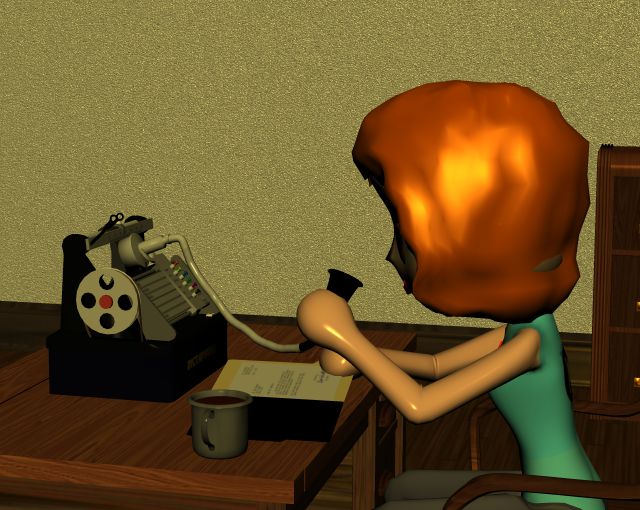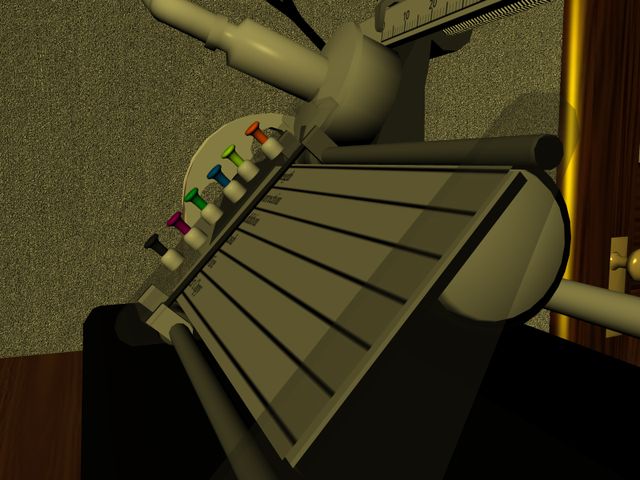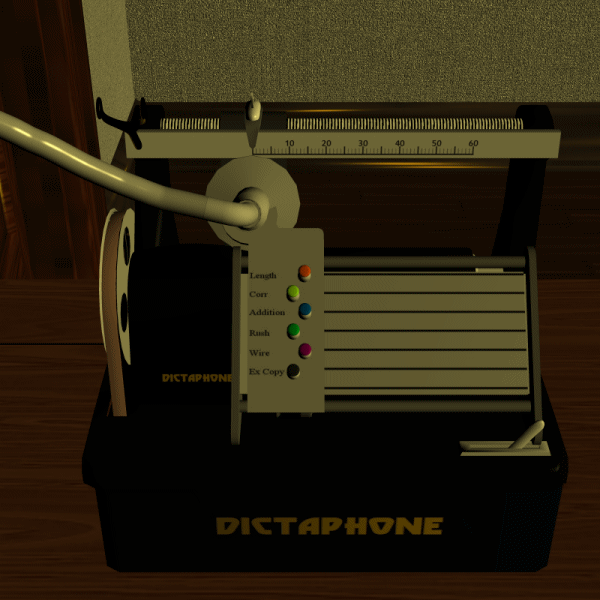Monday, June 01, 2020
Metadata, 1917 style
Let's revisit the linear vs circular theme, from clocks to recorders.
Would we think of time differently if we were accustomed to linear clocks? Would we value the rest of each day more, and use it more efficiently or enjoyably, if we could see and anticipate the consumption as we do on the Ridhwan and the scribal? I've found that modeling and animating these devices tends to steer my thinking in that direction. Constant exposure to the real thing should do even better.
The Dictaphone, like the Ridhwan clock, was strictly linear. Sound runs from one end of the cylinder to the other. This form of indication makes sense for a segment of audio. Only politicians emit endless loops of meaningless poison. Humans speak with a start, middle and end.
Later recording and playing machines lost the linearity, but still tried to create a linear indicator. Music LPs are circular with circumferential 'cuts' between songs or segments. Locating those cuts was tricky, requiring a steady hand and a good eye. Wire and tape recorders have no visible indications at all. Poulsen's original wire recorder had a circular dial that indicated position, with marker hands to record in a specific interval and guard other parts from erasure. Later wires and tapes lost the limiting feature and only had an odometer, which was unreliable because tape stretched and slipped.
Digital players don't have a physical reality, but typically represent the sound linearly as a wave pattern moving through a long rectangle. (Reverting to the first visual representations of sound before the phonograph.)
The typical Dictaphone cylinder ran one hour, and usually contained a variety of letters, telegrams, and documents. Dictaphone recordings were permanent, not automatically erased like wire or tape. Many offices had a separate shaving machine that could erase each cylinder a few times, but this wasn't the default. Archival permanence was seen as a feature, making the Dictaphone useful for legal proceedings where the audio of testimony could be retained 'as is'.
Dictaphone operators were required to keep track of the contents on a printed form, which was then rolled up inside the cylinder when it was put away in storage. The time track depended on observing the indicator on the top bar, which was error-prone. In modern terms the printed form was the metadata for the sound.
From a Westinghouse Manual For Dictators:
 Just under the button-panel is an ink ribbon, reeled over and under the paper platform.
Just under the button-panel is an ink ribbon, reeled over and under the paper platform.
 As the Dictaphone's transducer moved linearly over the cylinder, the Annotator tracked with it.
As the Dictaphone's transducer moved linearly over the cylinder, the Annotator tracked with it.
 When dictating, you'd push one of the buttons after you paused the Dictaphone's motor with the foot pedal, to indicate that you were about to start another item, or to mark a correction or a rush job or a telegram.
It's not clear from the patent how the Annotator would help on the transcribing end. There wasn't an easy way to write with pencil on the form, so the dictator would have to take the paper out later and fill in detailed notes, or else write the details separately on 'pink slip Form 631'.
= = = = =
Footnote: The Manual For Dictators included a splendid guide to effective communication. Syntax, structure, and style. Its approach to grammar was descriptive, not grammarrhoid. This seems to have been typical in the '20s; after WW2 the grammarrhoids regained dominance, especially in neocon and Deepstate circles.
= = = = =
Later, I bumped into this by accident. Five years ago I made a sort of Dictaphone-style clock in HTML, with unwrapped cylindrical tracks, resembling a spectrogram or periodic element chart. I don't remember anything about it now! The dude who programmed this must have been pretty smart.
= = = = =
Links for Early Recorders so far:
Poulsen's wire recorder
The last windup phono
The Dictaphone
Dictaphone annotator.
When dictating, you'd push one of the buttons after you paused the Dictaphone's motor with the foot pedal, to indicate that you were about to start another item, or to mark a correction or a rush job or a telegram.
It's not clear from the patent how the Annotator would help on the transcribing end. There wasn't an easy way to write with pencil on the form, so the dictator would have to take the paper out later and fill in detailed notes, or else write the details separately on 'pink slip Form 631'.
= = = = =
Footnote: The Manual For Dictators included a splendid guide to effective communication. Syntax, structure, and style. Its approach to grammar was descriptive, not grammarrhoid. This seems to have been typical in the '20s; after WW2 the grammarrhoids regained dominance, especially in neocon and Deepstate circles.
= = = = =
Later, I bumped into this by accident. Five years ago I made a sort of Dictaphone-style clock in HTML, with unwrapped cylindrical tracks, resembling a spectrogram or periodic element chart. I don't remember anything about it now! The dude who programmed this must have been pretty smart.
= = = = =
Links for Early Recorders so far:
Poulsen's wire recorder
The last windup phono
The Dictaphone
Dictaphone annotator.
Before beginning to dictate, the dictaphone should be located so that the dictator can talk directly into the mouthpiece of the tube and at the same time see notations on the letter to which he is replying. SPEAK DISTINCTLY AND ALWAYS SPELL UNUSUAL NAMES OR TERMS. Read carefully all the notations on the pink slip, Form 631. Indicate the length of each letter by the scale shown on the pink slip, Form 631, so that the typist can properly arrange the letter.= = = = = Here's a gimmick that took advantage of the Dictaphone's strict linearity. It was invented in 1917 by Martha Hunter. This gadget made it easy to register important points for the metadata. It didn't seem to help with reading the metadata, which may be why it was never manufactured.
Heretofore it has been proposed to supply a specially printed sheet, properly ruled and provided with stock phrases, said sheet to receive upon its face penciled marks made by the dictator to convey the necessary information relative to the matters in the record for the convenience of the transcriber. Great difficulty has been encountered by users of this memo sheet in properly marking it and also in locating from the marks thereon the position in the phonograph record of the matters to which such marks apply. In the present invention this objection has been overcome by the provision of mechanical means for carrying on these operations.It would have looked like this when mounted on a Dictaphone:
 Just under the button-panel is an ink ribbon, reeled over and under the paper platform.
Just under the button-panel is an ink ribbon, reeled over and under the paper platform.
 As the Dictaphone's transducer moved linearly over the cylinder, the Annotator tracked with it.
As the Dictaphone's transducer moved linearly over the cylinder, the Annotator tracked with it.
 When dictating, you'd push one of the buttons after you paused the Dictaphone's motor with the foot pedal, to indicate that you were about to start another item, or to mark a correction or a rush job or a telegram.
It's not clear from the patent how the Annotator would help on the transcribing end. There wasn't an easy way to write with pencil on the form, so the dictator would have to take the paper out later and fill in detailed notes, or else write the details separately on 'pink slip Form 631'.
= = = = =
Footnote: The Manual For Dictators included a splendid guide to effective communication. Syntax, structure, and style. Its approach to grammar was descriptive, not grammarrhoid. This seems to have been typical in the '20s; after WW2 the grammarrhoids regained dominance, especially in neocon and Deepstate circles.
= = = = =
Later, I bumped into this by accident. Five years ago I made a sort of Dictaphone-style clock in HTML, with unwrapped cylindrical tracks, resembling a spectrogram or periodic element chart. I don't remember anything about it now! The dude who programmed this must have been pretty smart.
= = = = =
Links for Early Recorders so far:
Poulsen's wire recorder
The last windup phono
The Dictaphone
Dictaphone annotator.
When dictating, you'd push one of the buttons after you paused the Dictaphone's motor with the foot pedal, to indicate that you were about to start another item, or to mark a correction or a rush job or a telegram.
It's not clear from the patent how the Annotator would help on the transcribing end. There wasn't an easy way to write with pencil on the form, so the dictator would have to take the paper out later and fill in detailed notes, or else write the details separately on 'pink slip Form 631'.
= = = = =
Footnote: The Manual For Dictators included a splendid guide to effective communication. Syntax, structure, and style. Its approach to grammar was descriptive, not grammarrhoid. This seems to have been typical in the '20s; after WW2 the grammarrhoids regained dominance, especially in neocon and Deepstate circles.
= = = = =
Later, I bumped into this by accident. Five years ago I made a sort of Dictaphone-style clock in HTML, with unwrapped cylindrical tracks, resembling a spectrogram or periodic element chart. I don't remember anything about it now! The dude who programmed this must have been pretty smart.
= = = = =
Links for Early Recorders so far:
Poulsen's wire recorder
The last windup phono
The Dictaphone
Dictaphone annotator.Labels: Language update, Patient things
